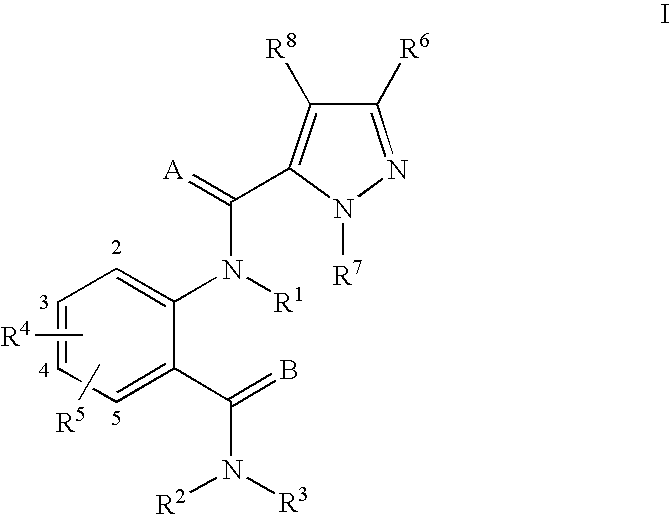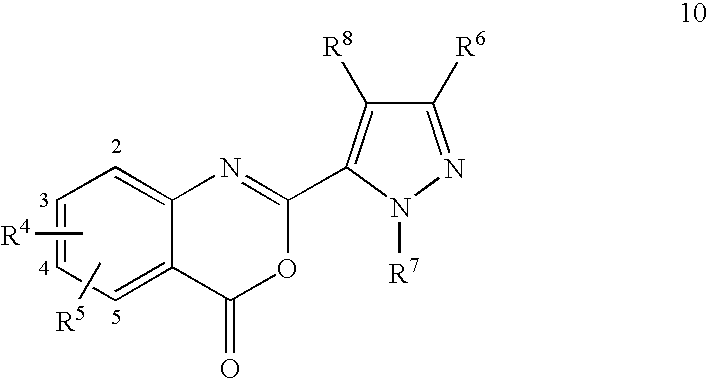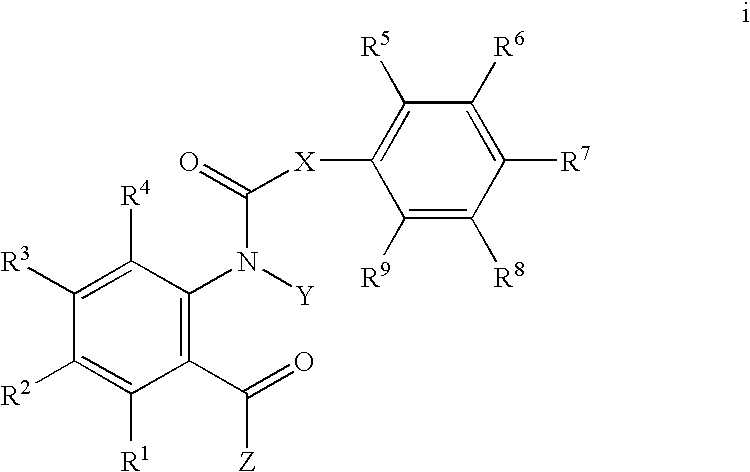Method for controlling particular insect pests by applying anthranilamide compounds
an anthranilamide and compound technology, applied in the field of particular insect pest control by compound application, can solve the problems of significant productivity reduction and increased costs for consumers
- Summary
- Abstract
- Description
- Claims
- Application Information
AI Technical Summary
Problems solved by technology
Method used
Image
Examples
example 1
Preparation of 2-[1-Ethyl-3-trifluoromethylpyrazol-5-yl carbamoyl]-3-methyl-N-(1-methylethyl)benzamide
Step A: Preparation of 3-Methyl-N-(1-methylethyl)-2-nitrobenzamide
[0141]A solution of 3-methyl-2-nitrobenzoic acid (2.00 g, 11.0 mmol) and triethylamine (1.22 g, 12.1 mmol) in 25 mL of methylene chloride was cooled to 10° C. Ethyl chloroformate was carefully added and a solid precipitate formed. After stirring for 30 minutes isopropylamine (0.94 g, 16.0 mmol) was added and a homogeneous solution resulted. The reaction was stirred for an additional hour, poured into water and extracted with ethyl acetate. The organic extracts were washed with water, dried over magnesium sulfate and evaporated under reduced pressure to afford 1.96 g of the desired intermediate as a white solid melting at 126-128° C.
[0142]1H NMR (CDCl3) δ 1.24 (d, 6H), 2.38 (s, 3H), 4.22 (m, 1H), 5.80 (br s, 1H), 7.4 (m, 3H).
Step B: Preparation of 2-Amino-3-methyl-N-(1-methylethyl)benzamide
[0143]The 2-nitrobenzamide of...
example 2
Preparation of N-[2-Methyl-6-[[(1-methylethyl)amino]carbonyl]phenyl]-1-phenyl-3-(trifluoromethyl)-1H-pyrazole-5-carboxamide
Step A: Preparation of 2-Methyl-1-phenyl-4-(trifluoromethyl)-1H-pyrazole
[0150]A solution of 1,1,1-trifluoropentane-2,4-dione (20.0 g, 0.130 mole) in glacial acetic acid (60 mL) was cooled to 7° C. using an ice / water bath. Phenylhydrazine (14.1 g, 0.130 mole) was added dropwise over a period of 60 minutes. The reaction mass temperature increased to 15° C. during the addition. The resulting orange solution was held under ambient conditions for 60 minutes. The bulk of the acetic acid was removed by stripping on a rotary evaporator at a bath temperature of 65° C. The residue was dissolved in methylene chloride (150 mL). The solution was washed with aqueous sodium bicarbonate (3 g in 50 mL of water). The purple-red organic layer was separated, treated with activated charcoal (2 g) and MgSO4, then filtered. Volatiles were removed on a rotary evaporator. The crude prod...
example 3
Preparation of N-[2-Methyl-6-[[(1-methylethyl)amino]carbonyl]-phenyl]-3-(trifluoromethyl)-1-[3-(trifluoromethyl)-2-pyridinyl]-1H-pyrazole-5-carboxamide
Step A: Preparation of 3-Trifluoromethyl-2-[3-(trifluoromethyl)-1H-pyrazol-1-yl]pyridine
[0158]A mixture of 2-chloro-3-trifluoromethylpyridine (3.62 g., 21 mmol), 3-trifluoro-methylpyrazole (2.7 g., 20 mmol), and potassium carbonate (6.0 g, 43 mmol) were heated at 100° C. for 18 h. The cooled reaction mixture was added to ice / water (100 mL). The mixture was extracted twice with ether (100 mL) and the combined ether extracts were washed twice with water (100 mL). The organic layer was dried with magnesium sulfate and concentrated to an oil. Chromatography on silica gel with hexanes:ethyl acetate (8:1 to 4:1) as eluent gave the title compound (3.5 g) as an oil.
[0159]1H NMR (CDCl3) δ 6.75 (m, 1H), 7.5 (m, 1H), 8.2 (m, 2H), 8.7 (m, 1H).
Step B: Preparation of 3-(Trifluoromethyl)-1-[3-(trifluoromethyl)-2-pyridinyl]-1H-pyrazole-5-carboxylic a...
PUM
 Login to View More
Login to View More Abstract
Description
Claims
Application Information
 Login to View More
Login to View More - R&D
- Intellectual Property
- Life Sciences
- Materials
- Tech Scout
- Unparalleled Data Quality
- Higher Quality Content
- 60% Fewer Hallucinations
Browse by: Latest US Patents, China's latest patents, Technical Efficacy Thesaurus, Application Domain, Technology Topic, Popular Technical Reports.
© 2025 PatSnap. All rights reserved.Legal|Privacy policy|Modern Slavery Act Transparency Statement|Sitemap|About US| Contact US: help@patsnap.com



